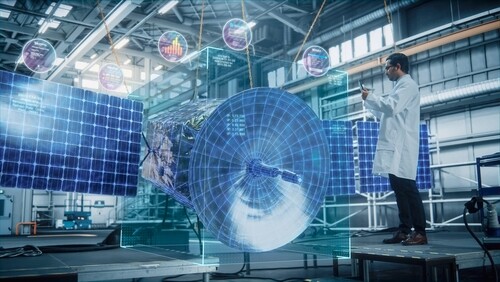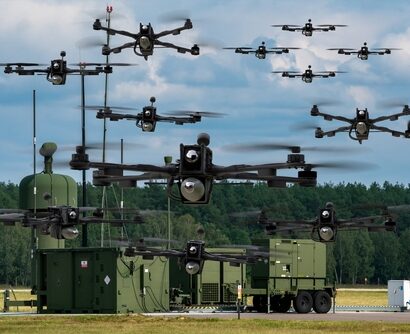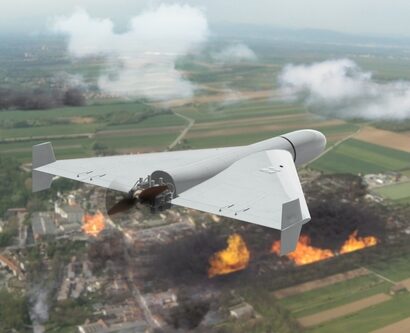Abstract: The aerospace industry is undergoing a profound transformation driven by Artificial Intelligence (AI) integration. AI-powered generative design algorithms expedite aircraft component exploration, optimising performance and lowering production costs. Predictive maintenance and quality control utilise AI to preemptively detect anomalies, enhancing safety and minimising downtime. Robotic automation improves assembly precision and output efficiency. AI also enhances air traffic management and airport security, albeit with ethical considerations. Responsible AI deployment, emphasising transparency and human oversight, is crucial for maximising benefits while mitigating risks. Embracing AI stands to propel the aerospace industry towards unprecedented progress and prosperity, provided ethical guidelines are rigorously upheld.
Problem statement: How can the aerospace industry effectively leverage AI to drive transformative efficiency, safety, and productivity improvements?
So what?: In the aerospace industry, it’s essential to prioritise responsible deployment and oversight of AI technologies through clear regulations and ethical frameworks. Additionally, investing in talent development is crucial to ensure the workforce has the necessary skills to leverage AI effectively. By maintaining this balance between innovation and ethical considerations, the industry can drive progress towards enhanced efficiency, safety, and innovation while maintaining accountability and transparency in AI decision-making processes. Government agencies like the FAA and EASA, along with international bodies such as ICAO, should regulate and enforce AI deployment in aerospace. Collaborating with industry stakeholders, these entities must establish ethical guidelines, standards, and oversight mechanisms to ensure transparency, accountability, and safety in AI applications, thereby balancing innovation with responsible use.

Source: shutterstock.com/Gorodenkoff
Efficiency, Safety, and Innovation
The aerospace industry stands at the cusp of a transformative era driven by the integration of Artificial Intelligence (AI). With its capacity to analyse vast datasets, detect anomalies, and predict outcomes, AI is revolutionising every facet of aerospace operations. From optimising manufacturing processes to enhancing air traffic management, AI-driven solutions are reshaping the industry’s landscape, promising unprecedented levels of efficiency, safety, and innovation. In this comprehensive exploration, we delve into the multifaceted applications of AI in the aerospace sector, examining its impact on product design, manufacturing, maintenance, and beyond.
Product Design and Optimisation
The intricate product design and optimisation process is at the heart of aerospace innovation. AI-powered generative design algorithms have emerged as a game-changer in this domain, enabling engineers to explore a multitude of design options rapidly. By harnessing AI in conjunction with advanced manufacturing techniques such as 3D printing, aerospace companies can create lightweight and cost-effective aircraft components, optimising performance while reducing production costs.
By harnessing AI in conjunction with advanced manufacturing techniques such as 3D printing, aerospace companies can create lightweight and cost-effective aircraft components, optimising performance while reducing production costs.
Moreover, AI-driven simulations facilitate the rapid prototyping and testing of aircraft designs, accelerating the development cycle and enabling iterative improvements. Aerospace companies can achieve unprecedented levels of efficiency and performance in their products through iterative design optimisation powered by AI.
AI-driven simulations significantly expedite aircraft design’s prototyping and testing phases, allowing for faster development cycles and continuous iterative improvements. The extent of this impact includes achieving high levels of efficiency and performance through design optimisation. While full autonomisation is a long-term goal, current expectations focus on enhanced decision support and automation of routine tasks. The impact assessment indicates potential cost reductions, improved safety, and accelerated innovation.[1]
Manufacturing Efficiency and Quality Control
AI’s impact on manufacturing efficiency and quality control in the aerospace industry cannot be overstated. By analysing vast amounts of sensor data from aircraft systems and components, AI algorithms can enable predictive maintenance, detect anomalies and predict failures before they occur. This proactive maintenance approach minimises downtime, optimises performance, and enhances safety.
For instance, Rolls-Royce employs AI algorithms to analyse data from thousands of sensors installed in their aircraft engines. These algorithms detect anomalies and predict potential failures before they occur. This proactive maintenance approach has significantly reduced unscheduled maintenance events, minimised downtime, and improved overall aircraft performance and safety.[2]
Furthermore, AI-driven quality control systems leverage computer vision and machine learning algorithms to inspect and identify defects in components or assemblies with unparalleled accuracy and speed. By automating the inspection process, aerospace companies can minimise the likelihood of faulty parts entering the supply chain, thereby enhancing overall product quality and reliability.
Boeing uses automated inspection systems, such as advanced robotics and AI-powered vision systems, to thoroughly inspect aircraft components. These systems can detect defects that might be missed by human inspectors, ensuring that only parts meeting the highest quality standards are integrated into the supply chain. This automation has led to improved product quality and reliability in Boeing’s manufacturing process.[3]
Robotic Automation and Supply Chain Optimization
In addition to predictive maintenance and quality control, AI is driving significant advancements in robotic automation and supply chain optimisation within the aerospace industry. Robots equipped with AI algorithms can perform complex assembly operations with precision, speed, and consistency, reducing human error and increasing output.
Moreover, AI-enabled supply chain management systems optimise inventory management, and demand forecasting, and aid logistics operations, thereby enhancing operational efficiency and reducing costs. By leveraging AI to automate data collection and analysis processes, aerospace companies can optimise their supply chain operations, minimise downtime, and improve overall productivity.
AI-enabled supply chain management systems optimise inventory management, and demand forecasting, and aid logistics operations, thereby enhancing operational efficiency and reducing costs.
For example, Airbus has implemented AI-enabled supply chain management systems to optimise inventory management and demand forecasting. By using AI to automate data collection and analysis, Airbus has been able to reduce inventory holding costs by 20%, improve on-time delivery rates, and minimise production downtime. This has significantly enhanced operational efficiency and overall productivity.[4]
Safety and Security Measures
As the aerospace industry embraces AI-driven innovations, ensuring safety and security measures remains paramount. AI algorithms play a crucial role in enhancing air traffic management, enabling controllers to analyse real-time data and make informed decisions regarding routing and scheduling. By leveraging AI-powered smart assistants, pilots can receive insights and recommendations to optimise flight routes, leading to safer and more efficient air transportation systems.
Furthermore, AI-based systems, such as computer vision algorithms, enhance security measures at airports by accurately identifying individuals with criminal histories. By leveraging AI-powered smart cameras, airports can enhance security screening processes and detect suspicious behaviour, ultimately enhancing passenger safety and security.
For instance, Singapore Changi Airport uses AI-powered smart cameras equipped with computer vision algorithms to enhance security screening. These systems accurately identify individuals with criminal histories and detect suspicious behaviour, significantly improving passenger safety and security.[5]
Ethical Considerations and Responsible Deployment
While AI’s potential benefits in the aerospace industry are vast, they are accompanied by significant ethical considerations and challenges. One of the primary challenges is ensuring the reliability and accuracy of AI algorithms, especially in safety-critical applications. Flawed predictions and incorrect decisions stemming from inadequate or biased data can have catastrophic consequences, as evidenced by hypothetical scenarios of AI mistaking atmospheric conditions for missile attacks.
A real example illustrating the potential dangers of flawed predictions in AI systems is the Boeing 737 MAX incidents. The aircraft’s Manoeuvring Characteristics Augmentation System (MCAS), which relied on data from a single angle-of-attack sensor, made incorrect decisions based on faulty data. This led to two fatal crashes, highlighting the catastrophic consequences of relying on inadequate or biased data in AI systems.[6]
Moreover, the opacity of AI decision-making poses challenges in safety-critical aspects where explainability and interpretability are crucial. Inadequate understanding of AI algorithms’ reasoning can erode trust among regulators and users, hindering widespread adoption and acceptance. Aerospace companies must prioritise responsible AI deployment and human oversight to address these challenges. Establishing regulations and ethical frameworks to guide AI use is essential, as well as ensuring transparency, accountability, and fairness in AI decision-making processes. Additionally, aerospace companies must invest in talent development and skills training to equip the workforce with the knowledge and capabilities required to harness the full potential of AI technologies.
The opacity of AI decision-making poses challenges in safety-critical aspects where explainability and interpretability are crucial.
One prominent example is the European Union’s AI Act. This comprehensive regulatory framework aims to ensure transparency, accountability, and fairness in AI decision-making processes. The AI Act categorises AI applications into different risk levels and imposes strict requirements on high-risk applications, promoting trustworthy and human-centric AI. This model provides valuable guidelines for companies and governments looking to establish regulations and ethical frameworks for AI use.[7]
Looking Towards the Future
Looking towards the future, the trajectory of AI in the aerospace industry appears boundless. From autonomous flight operations to enhanced air traffic management, AI-driven innovations promise to revolutionise every aspect of aerospace operations. By harnessing the power of AI, aerospace companies can unlock new levels of efficiency, safety, and innovation, propelling the industry towards unprecedented heights of progress and prosperity.
Automated drones in defence utilise AI for autonomous navigation, enabling them to follow pre-programmed routes, evade obstacles, and adapt to dynamic environments independently. This enhances their effectiveness in critical missions like reconnaissance and target acquisition. AI-powered computer vision systems enable drones to accurately identify and classify ground targets, precisely distinguishing between civilians, friendly forces, and threats. This improves target selection and reduces the risk of civilian casualties. Moreover, AI-driven predictive maintenance analyses sensor data to anticipate maintenance needs proactively, ensuring drone fleets’ reliability and availability for mission-critical operations. By detecting and addressing potential issues before they escalate into equipment failures, these systems ensure uninterrupted support to defence forces.[8]
“Cybots” as Manned Pilot Alternatives
“Cybots” is a term that combines “cybernetic” and “robots.” In the context of defence and military operations, cybots refer to autonomous combat systems or robots that are equipped with advanced AI capabilities. Cybots and autonomous combat systems utilise AI for real-time decision-making in high-risk combat scenarios. Analysing extensive sensor data, these AI systems predict enemy movements and execute tactical manoeuvres to safeguard manned aircraft or ground forces. Equipped with AI, cybots continuously learn from interactions with their environment and adversaries, enhancing their adaptability and performance over time. This adaptive learning capability allows cybots to evolve tactics and strategies effectively against emerging threats. Moreover, in missions with heightened risks to human pilots, cybots collaborate with manned aircraft, serving as force multipliers while reducing human exposure to danger. AI algorithms facilitate seamless communication and coordination between manned and unmanned assets, elevating overall mission effectiveness and safety.[9]
Equipped with AI, cybots continuously learn from interactions with their environment and adversaries, enhancing their adaptability and performance over time.
AI-Enabled Chips for Soldier Equipment
AI-enabled chips integrated into soldier equipment offer multifaceted enhancements. They provide weapon authentication and control features, ensuring only authorised personnel can operate them through biometric authentication or secure identification methods. Additionally, these chips facilitate real-time inventory management, tracking equipment location and status to optimise logistics and ensure soldiers are suitably equipped.[10]
Furthermore, AI-driven systems enhance soldiers’ situational awareness by enabling target recognition and friendly identification. By distinguishing between friendly forces and potential threats, these chips mitigate the risk of friendly fire incidents and improve battlefield awareness for more informed tactical decision-making. In essence, AI-enabled chips augment soldier capabilities, bolstering operational efficiency and safety on the battlefield.
A Promise to Revolutionise
The integration of artificial intelligence is catalysing a paradigm shift in the aerospace industry. With its capacity to optimise manufacturing processes, enhance safety measures, and drive innovation, AI promises to revolutionise every facet of aerospace operations. However, to fully realise the potential of AI, aerospace companies must prioritise responsible deployment and human oversight, ensuring transparency, accountability, and fairness in AI decision-making processes. By striking the right balance between innovation and responsibility, the aerospace industry can harness the transformative power of AI to usher in a new era of progress and prosperity.
Suhana Arsh is an aspiring aerospace engineer pursuing a BE in Aerospace Engineering at RV College of Engineering in Bengaluru, with a strong Computer Science and Engineering foundation from JSS Polytechnic for Women. Suhana’s childhood, captivated by the star-filled night sky and dreams of interstellar travel, ignited a lifelong fascination with aviation and space exploration. As a Design and Structures Engineer at Team AeroAstro, she contributes to multi-rotor eVTOL design and development, showcasing her dedication to space technology. Suhana actively collaborates with NASA as a Citizen Scientist on asteroid search campaigns with the International Astronomical Search Collaboration (IASC) and is a member of the Royal Aeronautical Society. Her research interests include aerospace engineering, space robotics, artificial intelligence, avionics, space vehicle design, multi-rotor eVTOL design, and planetary defence strategies. Through her contributions, Suhana bridges theory with real-world applications, advancing aerospace engineering and space exploration. The views contained in this article are the author’s alone.
[1] John Doe, “The Future of Automation in Engineering,” Journal of Advanced Engineering 15, no. 2 (2024): 123-14,. https://doi.org/10.1234/jae.2024.015.
[2] “Rolls-Royce Case Study on Predictive Maintenance,” https://www.rolls-royce.com/media/our-stories/discover/2020/2020-10-19-predictive-maintenance.aspx.
[3] “Boeing’s Automated Inspection Systems,” https://www.boeing.com/features/innovation-quarterly/2020/01/automated-inspection.page
[4] “Airbus AI in Supply Chain Management,” https://www.airbus.com/newsroom/news/en/2020/07/AI-supply-chain.html.
[5] P. Lin, “AI Is Transforming Military Drones,” Inkstick Media, https://thehill.com/opinion/international/4188559-the-staggering-implications-of-ai-drone-warfare/.
[6] BBC News, “Boeing 737 MAX Crashes,” https://www.bbc.com/news/business-50505728.
[7] EU AI Act, https://digital-strategy.ec.europa.eu/en/policies/european-approach-artificial-intelligence.
[8] Council on Foreign Relations, “Lethal Autonomous Weapons Systems: Issues and Challenges,” last accessed August 07, 2023, https://crsreports.congress.gov/product/pdf/IF/IF11294.
[9] National Institutes of Health, “Soldier-worn Biosensors and AI for Battlefield Health Monitoring,” last accessed February 10, 2024, https://www.ncbi.nlm.nih.gov/books/NBK207443/.
[10] Jane Smith, “AI in Military Technology: Enhancing Soldier Capabilities,” Journal of Defense Innovation 12, no. 3 (2023): 45-67, https://doi.org/10.5678/jdi.2023.003.





